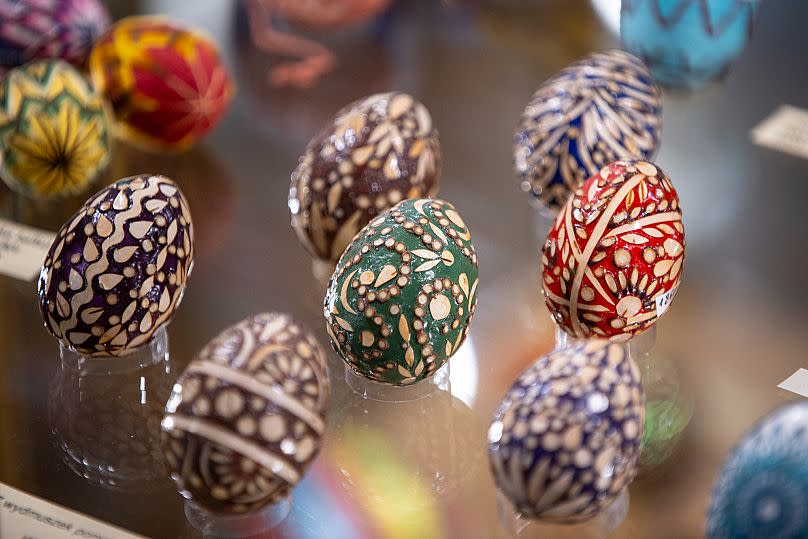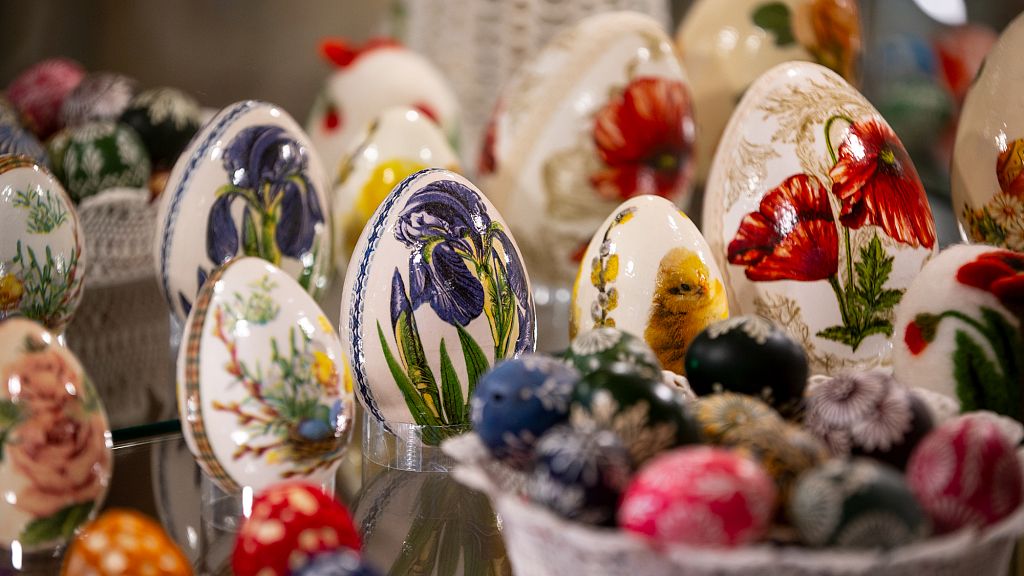A historic manor house in the picturesque Polish town of Ciechanowiec houses an extraordinary collection of Easter eggs from around the world. The Museum of Easter Eggs, which is part of the Kluk Priest Krzysztof Agricultural Museum, celebrated its 20th anniversary last year – it has been on the museum map of Poland since 3 April 2004.
The museum houses painted eggs from all seven continents, including Polish Easter eggs, known as “pisanki”, as well as their various international iterations. Here, visitors can learn about the history of the craft, and familiarize themselves with the different techniques employed by artisans of differing folk traditions.
2,752 Easter eggs, and it doesn’t stop there!
“At the moment we have a collection of exactly 2,752 Easter eggs. We are proud of all of them, because there is a story behind each one, there is a person behind each Easter egg,” Martyna Gieros from the ethnographic department of the Easter egg museum and the Agricultural Museum, says in an interview with Euronews.
The origins of the collection can be traced back to the private collections of a married couple of collectors – Irena Stasiewicz-Jasiukowa, a professor at the Polish Academy of Sciences and the University of Warsaw, and Jerzy Jasiuk, the long-time director of the Museum of Technology in Warsaw.
“Both were associated with Ciechanowiec – Jerzy as a long-standing member of the museum’s Scientific Council, while Irena took a scientific interest in the figure of Father Krzysztof Kluk, the patron of the institution. After years of collecting Easter eggs and presenting them at temporary exhibitions, they decided to donate their collection of around 1,000 exhibits to Ciechanowiec,” says Martyna Gieros.
The Jasiuk couple had been collecting Easter eggs for over thirty years – during holiday trips, research and study trips.
From a tiny African finch egg to an ostrich egg
The collection of the Ciechanowiec museum includes not only traditional Easter eggs made on chicken, duck or goose eggs, but also on much rarer eggs. The collection includes Easter eggs made on the eggs of peacocks, swans, storks and even those of ostriches, penguins and emu. Of particular interest to visitors are the miniature eggs of African finches and parrots, a real challenge for the creators, who embellished them with astounding detail.
One of the most unusual Easter eggs in the collection is a penguin egg brought back from Antarctica. Although it was already painted in Poland, the mere fact of having such a rare exhibit is unique. The collection also includes Easter eggs made of other materials – including wooden eggs, and some created from semi-precious stones.
Poppy seeds, groats and apple seeds
The techniques of egg decoration represented in the museum are as varied as the exhibits themselves. Visitors can admire Easter eggs made using the batik method (written in wax), engraved and engraved (with scratched designs), painted with oil, acrylic and poster paints, and decorated using the openwork technique, which involves cutting out designs directly into the shell.
Oftentimes, the traditional techniques of egg decoration include the use of natural “decorations”. “We have Easter eggs covered with natural grains, including poppy seeds, semolina, pasta or apple seeds,” says Martyna Gieros. The collection also includes pieces adorned with coloured yarn, cucumber seeds, rice or buckwheat seeds.

“Pisanki” from the collection of the Rev. K. Kluk Museum of Agriculture in Ciechanowiec. – Artur Warchala
From Kurpie through Africa and Bali to Antarctica – Easter eggs from all continents
The Museum in Ciechanowiec boasts exhibits from practically every corner of the world. In addition to “pisanki” from various regions of Poland (including the Podlasie, Kurpie, Kashubia and Podhale), the collection also includes traditional Slavic Easter eggs from Ukraine, Russia, and the Czech Republic.
However, the geographical reach of the collection extends far beyond Europe – including examples from China, Japan, Kenya, Indonesia, Australia and many other countries.
“Tourists come from Poland and from all over the world. They also bring their small works of art to us. As a result, the collection is not only about Polish Easter eggs – we have exhibits from virtually all continents,” – emphasises an employee of the museum.
The popularity of the museum makes more and more artists want to include their Easter eggs in the collection. “The museum is already so well-known that many people have heard about it. Of course, we are not able to accept everything. We conduct a selection, choosing the most interesting pieces. Techniques of making are important to us, and above all we try to collect the traditional ones,” explains Martyna Gieros.
From left: Bali, Indonesia, artist unknown; Melbourne, Australia, artist unknown; Easter eggs from the collection of the Rev. K. Kluk Museum of Agriculture in Ciechanowiec. – Artur Warchala
Easter eggs, an ancient form of folklore
Although today we associate decorated eggs mainly with Christian traditions and Easter, their history dates back to much earlier times. Researchers from the University of Cambridge claim that eggs were decorated in southern Africa as early as 60 thousand years ago.
The custom of decorating eggs was also associated with the solar cult of worship, where the egg symbolized the sun and light. Some of the oldest finds of dyed eggs come from Sumerian Mesopotamia, from where the custom spread throughout the Mediterranean area.
Dyed ostrich eggs were found in Egypt as early as 3000 BC. The tradition of painting eggs was eventually adopted by various cultures, including Persia, whose customs were later adopted by Christians, combining them with the symbolism of resurrection and the holiday of Easter.
In Slavic culture, this tradition was associated with the pagan holiday of Jare Gody, celebrating the end of winter. During this time, Slavs exchanged dyed eggs on the Day of Jare Gody.** They believed that after the winter, this ritual would guarantee them prosperity in the upcoming growing season and good harvests.
“The talisman in the form of an egg was also used when sowing fields – the sower would put it in his pocket or scatter it on the field. These practices were used in various parts of Europe, not only in Poland” – Martyna Gieros told Euronews.
However, the egg was not only of great importance in agricultural traditions.
“Once, it was believed that the egg, as a symbol of new life, was able to emanate life-giving energy. In many regions of the world, it was placed in the coffins of the deceased to breathe new life into them – although earthly life was ending, somewhere out there a second life would continue. The egg is also strongly associated with the spring equinox. It was then that it was supposed to have the greatest power, because everything is born to life then” – explains Gieros.
Interestingly, among the Slavs, the art of decorating Easter eggs or kraszanki (which are characterized by the fact that they are simply dyed a uniform color) was a task uniquely assigned to women. Girls prepared them in order to later offer them to boys as “redemption”, and to protect them from being doused with water on Easter Monday.
Easter egg museums around the world
The Easter egg museum in Ciechanowiec, although unique, is not the only place in the world with this type of collection. Similar establishments also exist in Ukraine (the famous Easter egg museum in Kolomyia, housed in a building shaped like a giant Easter egg), Russia, Hungary, Canada and several other places in Poland, where the Easter eggs are part of larger ethnographic collections.
However, the museum in Ciechanowiec stands out for its comprehensive approach to the subject, collecting exhibits from all over the world and documenting the various techniques and traditions associated with this fascinating aspect of folk art.
For lovers of folk art, ethnography and Easter traditions, a visit to the Easter Egg Museum in Ciechanowiec is an extraordinary journey through time and across continents. It shows how universal and culturally rich the custom of egg decoration is – one of the oldest expressions of human creativity, uniting communities all over the world.
Read the full article here


